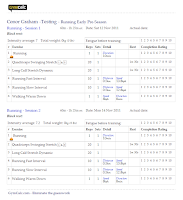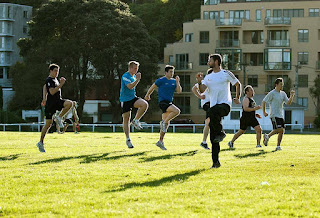Whether you want to run your first half marathon or your fastest 10k race, your arms can help. Incorrect arm mechanics could be costing you time, energy or even lower back pain.
Many runners are unknowingly slowing themselves down by keeping their hands too close to their chest, failing to swing from the shoulder and allowing their hands to come across the chest.
While these three habits may conserve energy in the arms and shoulders they ultimately cost us energy from our legs.
We swing our arms in time with our legs when we walk down the street. Our left elbow swings forward as our left knee comes back. On the other side our right knee moves forward as our right elbow swings back. Try to disrupt this rhythm and you'll soon realise how natural it is to us.
Try the same with a jog and you'll get the same result. Your body just doesn't want it to happen.
Our use of this natural rhythm is very different when sprinting as we are actively using our arms to make our legs move faster and through a longer stride. Watch the arm drive of any sprinter and you'll soon realise that that they seem to be putting as much, if not more effort into the driving their arms compared to the driving of their legs.
This is because although the legs are what propel us forward they rely on the arms to create an opposing force with which to propel off. Each time we drive an elbow down, on its way back, there is a downward force created which allows the foot to gain more traction and propulsion.
The faster the elbow is pulled back the stronger the knee can drive through in recovery for the next step. The higher the hands come the higher the knees can lift and the more time we spend gliding through the air.
Some allow their chest to turn left and right which is their bodies way of trying to balance what the legs are doing.
If you try to run with your arms by your side or pinned to your chest the you'll feel your chest trying to turn.
Watching the arms of any decent runner on TV, you'll notice that the elbow stays at an angle of around 90 degrees. Very few amateur runners hold this elbow position and in failing to do so lose efficiency.
Holding 90 degrees throughout the entire arm swing optimises the forces our arms can elicit on our legs regardless of whether we are sprinting, walking fast or running long distance.
Stand tall and, with straight arms, swing them at around the rate you'd expect your legs to move in your chosen running race. It's tough right? There's no way you'll be able to achieve an arm drive fast enough with this elbow position.
Now try swinging your arms with your hands tight to your chest. It will feel super easy and is actually quite a popular position for many amateur distance runners because it feels like they're saving energy. The problem is that they're not using their arms to counter the movement of the legs so end up rotating the chest instead.
Turning the chest while you run is going to use far more energy than swinging your arms and can also lead to back pain as your torso is constantly bracing itself for each step in a rotated position.
 Your forearms should always aim parallel to one another in order to support the same alignment in your legs. If your hands are swinging in front of your belly button then they're going to create rotational forces through your torso which effect your legs.
Your forearms should always aim parallel to one another in order to support the same alignment in your legs. If your hands are swinging in front of your belly button then they're going to create rotational forces through your torso which effect your legs.
If you can learn to keep the elbows at 90 then learning to swing your elbows forward and back, instead of across your chest should come a little easier. If there's any muscle soreness it'll be in the back of your shoulder where your muscle have to work to prevent your hands coming across your body.
So, which of these changes could you utilise to help you run faster?
Have you tried implementing of them yet? How's it going?
Changing your technique can be frustrating as it will actually make you more tired in the short term but will uncap your potential in the long run.
As part of the Cheltenham Running Club, we offer one to one and small group running technique workshops to not only provide the changes but also the feedback and fine tuning to help make the new habits stick.
If you're not able to come to Cheltenham then we may be able to provide coaching through video analysis and a Customised Running Technique Programme.
Many runners are unknowingly slowing themselves down by keeping their hands too close to their chest, failing to swing from the shoulder and allowing their hands to come across the chest.
While these three habits may conserve energy in the arms and shoulders they ultimately cost us energy from our legs.
Co-ordinating Arm and Leg Drive
Try it Yourself
Walk with your right elbow swinging forward at the same time as your right knee and repeat on the other side for 20m.Try the same with a jog and you'll get the same result. Your body just doesn't want it to happen.
Arm Drive in Sprinting
This is because although the legs are what propel us forward they rely on the arms to create an opposing force with which to propel off. Each time we drive an elbow down, on its way back, there is a downward force created which allows the foot to gain more traction and propulsion.
The faster the elbow is pulled back the stronger the knee can drive through in recovery for the next step. The higher the hands come the higher the knees can lift and the more time we spend gliding through the air.
Arm Drive for Distance Runners
All of this is very important for sprinters but not so useful for amateur long distance runners who will be doing well to have any energy left for a sprint finish. None the less, many people do not use their arms at all and therefore mess up the natural rhythm of their running.Some allow their chest to turn left and right which is their bodies way of trying to balance what the legs are doing.
If you try to run with your arms by your side or pinned to your chest the you'll feel your chest trying to turn.
Correct Elbow Position for Distance Running
Holding 90 degrees throughout the entire arm swing optimises the forces our arms can elicit on our legs regardless of whether we are sprinting, walking fast or running long distance.
Try it Yourself
Stand tall and, with straight arms, swing them at around the rate you'd expect your legs to move in your chosen running race. It's tough right? There's no way you'll be able to achieve an arm drive fast enough with this elbow position.
Now try swinging your arms with your hands tight to your chest. It will feel super easy and is actually quite a popular position for many amateur distance runners because it feels like they're saving energy. The problem is that they're not using their arms to counter the movement of the legs so end up rotating the chest instead.
Turning the chest while you run is going to use far more energy than swinging your arms and can also lead to back pain as your torso is constantly bracing itself for each step in a rotated position.
Correct Forearm Alignment for Distance Running
 Your forearms should always aim parallel to one another in order to support the same alignment in your legs. If your hands are swinging in front of your belly button then they're going to create rotational forces through your torso which effect your legs.
Your forearms should always aim parallel to one another in order to support the same alignment in your legs. If your hands are swinging in front of your belly button then they're going to create rotational forces through your torso which effect your legs.
Keep the hands in the same line as your shoulders and you'll feel more balanced when you run. Holding this alignment will feel like you've got your hands outside the width of your elbows, not a glamorous look, if you're actually doing it but the sensation will go away as the muscles regain their natural, stronger, position.
Making the Changes to your Running Technique
Keeping the elbows at 90 degrees is often the hardest to change as far as habits go. If you can actually manage to keep the elbows in the correct position, expect to have some sore biceps one day after or even during the first run.If you can learn to keep the elbows at 90 then learning to swing your elbows forward and back, instead of across your chest should come a little easier. If there's any muscle soreness it'll be in the back of your shoulder where your muscle have to work to prevent your hands coming across your body.
So, which of these changes could you utilise to help you run faster?
Have you tried implementing of them yet? How's it going?
Changing your technique can be frustrating as it will actually make you more tired in the short term but will uncap your potential in the long run.
As part of the Cheltenham Running Club, we offer one to one and small group running technique workshops to not only provide the changes but also the feedback and fine tuning to help make the new habits stick.
If you're not able to come to Cheltenham then we may be able to provide coaching through video analysis and a Customised Running Technique Programme.












